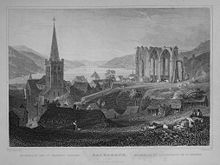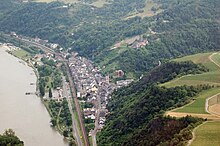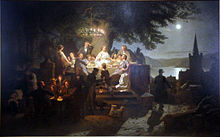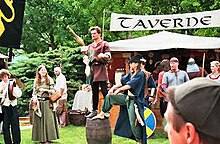Bacharach
| coat of arms | Germany map | |
|---|---|---|

|
Coordinates: 50 ° 4 ′ N , 7 ° 46 ′ E |
|
| Basic data | ||
| State : | Rhineland-Palatinate | |
| County : | Mainz-Bingen | |
| Association municipality : | Rhine-Nahe | |
| Height : | 70 m above sea level NHN | |
| Area : | 23.33 km 2 | |
| Residents: | 1867 (Dec. 31, 2019) | |
| Population density : | 80 inhabitants per km 2 | |
| Postal code : | 55422 | |
| Area code : | 06743 | |
| License plate : | MZ , BIN | |
| Community key : | 07 3 39 003 | |
| LOCODE : | DE DCH | |
| City structure: | 5 districts | |
| Association administration address: | Koblenzer Strasse 18 55411 Bingen am Rhein |
|
| Website : | ||
| City Mayor : | vacant (substitute: first alderman Gunter Pilger) | |
| Location of the city of Bacharach in the Mainz-Bingen district | ||
Bacharach ([ ˈbaxarax ] also known as Bacharach am Rhein ) is a town in the UNESCO World Heritage Upper Middle Rhine Valley in the Mainz-Bingen district in Rhineland-Palatinate . The original name Baccaracus suggests a Celtic origin. Stahleck Castle (now a youth hostel ) rises above the village .
Bacharach is designated as a basic center according to the state planning .
location
Bacharach is part of the Upper Middle Rhine Valley cultural landscape and the Middle Rhine region with its wine-growing region of the same name . Bacharach is located in the far north of the Rhineland-Palatinate district of Mainz-Bingen, about 15 kilometers northwest of Bingen am Rhein . In the east of the urban area the Rhine flows, which forms the border from Bacharach here. The village is connected to the Hunsrück by the Steeger Tal with the Winzbach and the Blücherstraße (L 224) that runs there . The central place there is Rheinböllen . The districts on the Hunsrückhöhe have their own access roads to the Rhine.
Districts
Bacharach is divided into several districts. The Steeg district is located in the Steeger Tal, a side valley of the Rhine. This part of the city flows smoothly into the city. The other parts of the city are well above Bacharach, Medenscheid and Neurath in the south and Henschhausen in the north on the hill.
history
Bacharach was first mentioned in a document at the beginning of the 11th century. As early as the 7th century, the royal area became the property of the Cologne bishop Kunibert (this is indicated by a "Kunibert chapel" in place of today's Werner chapel). The governors of the Cologne property were the Count Palatine , who over time pushed back Cologne's influence. Count Palatine Hermann von Stahleck had so much influence that he now resides at Stahleck Castle. The daughter of his successor Konrad von Staufen secretly marries a son of the warring family of the Guelphs at Stahleck Castle . As a result, Bacharach and the entire Palatinate County fell to Heinrich von Braunschweig for a short time . In 1214 the Wittelsbach count palatine became the new masters of Bacharach. Together with the Unteramt Kaub, they received their most important source of customs and income here. 1314 was decided here Ludwig of Bavaria to the German king to choose. Bacharach was also the most important reloading station for the wine trade, as this was where the barrels from smaller ships that could only pass the Binger Loch were loaded onto larger ones . From now on the wine was called "Bacharacher". Bacharach also gained importance through the timber trade from the Hunsrück and received city rights in 1356 .


The Gothic Wernerkapelle is visible from afar , it is a Rhine-romantic landmark of the city and is on the way to Stahleck Castle from the city. Its construction was built around 1293 (first consecration of a Werner altar in the south wing) on the site of the older Kunibert chapel as a pilgrimage chapel and financed with contributions from the pilgrims, but was only completed after 1426. When the castle was blown up (1689) it was badly damaged and then fell into ruin. The namesake is the formerly "holy" Werner von Oberwesel . According to the typical Christian ritual murder legend of the time , the 16-year-old is said to have been murdered on Maundy Thursday in 1287 by fellow citizens of the local Jewish community who used his blood for the Passover . The anti-Semitic murder and pogrommob rose up on the alleged ritual murder and destroyed not only Jewish communities on the Middle Rhine, but also on the Moselle and in the Lower Rhine area. The Werner cult arose in the popular Christianity. It was not until 1963 that Werner was deleted from the diocese of Trier's calendar of saints .
The construction of the city wall began in 1344 and was completed around 1400. In 1545 the city and the Palatinate became Protestant under Count Palatine Friedrich II. However, Stahleck Castle and the city wall could not prevent Bacharach from changing occupation and thus the prevailing religion eight times during the Thirty Years War , beginning with the Spanish occupation by Ambrosio Spinola in 1620, which lasted until 1632, and was repeatedly plundered. Several city fires also caused destruction. In 1689, French troops finally blew up Stahleck Castle and four towers of the city wall in the War of the Palatinate Succession .
In 1794 French revolutionary troops occupied the left bank of the Rhine . From 1798 to 1814, after the Treaty of Lunéville , Bacharach belonged to the Département de Rhin-et-Moselle and was the chief town ( chef-lieu ) of a canton . During the Napoleonic Wars of Liberation , the Prussian Field Marshal Blücher moved with his troops through Bacharach and the Steeger Valley towards France after crossing the Rhine at Kaub on New Year's Eve 1813/1814. A memorial stone a little downstream across from Kaub commemorates this event. After the Congress of Vienna , the city went to Prussia in 1815, along with the left bank of the Rhine up to and including Bingerbrück . After the silting of the harbor Bacharach fell into a slumber from which it only in the course of the Rhine romanticism was brought back, the end of the 18th century. The description of Friedrich Schlegel's Rhine journey in 1802 and the ballad Lore Lay , composed by Clemens Brentano around 1800, sparked early tourism on the Rhine. The lifting of the French continental blockade in 1814 brought the British aristocracy to the Rhine Valley, which gained a stir in England through Lord Byron. The French writer Victor Hugo was one of the first important visitors in 1840 . As part of the regulation of the Rhine in 1850, the Ara Bacchi was blown up near Bacharach .
The care and preservation of the architectural monuments of Bacharach, promoted in the early 20th century by the Rhenish Association for Monument Preservation and Landscape Protection, which particularly took care of the then highly endangered city wall and the ruins of Stahleck Castle, and the strong commitment of the State of Rhineland-Palatinate to the Werner Chapel made sure that Bacharach is still a gem of Rhine romanticism and a multifaceted testimony to medieval architecture on the Middle Rhine. The ruins of the Wernerkapelle are protected as a historical monument and in front of it there is a memorial plaque to commemorate the inhuman crimes against the Jewish fellow citizens, which a prayer quotation from Pope John XXIII. about the change of mind of Christians in their relationship to the Jews contains:
“Today we recognize that centuries of blindness have covered our eyes so that we no longer saw the beauty of your chosen people and no longer recognized the features of our firstborn brother. We now discover that there is a mark of Cain on our forehead. Over the centuries, our brother Abel has lain in the blood we shed and he has wept the tears we caused because we forgot your love. Forgive us the curse we wrongly attached to the names of the Jews. Forgive us that we crucified you a second time in her flesh. Because we didn't know what we were doing ... "
Today Bacharach lives from tourism and the wine from Bacharach still enjoys international popularity. Problems due to a shrinking population due to a lack of prospects cannot be overlooked.
Incorporations
On June 7, 1969, the previously independent municipality of Steeg with its 852 inhabitants at the time was incorporated into Bacharach.
Population development
The development of the population in relation to today's urban area of Bacharach, the values from 1871 to 1987 are based on censuses:
|
|
religion
In 2013, 47.4 percent of the population were Protestant and 30.7 percent Catholic. The rest belonged to another religion or were non-denominational.
politics
City council
The city council in Bacharach consists of 16 council members, who were elected in a personalized proportional representation in the local elections on May 26, 2019 , and the honorary city mayor as chairman. However, this position is currently vacant, as no candidate ran in the local elections and the previous mayor Karl-Heinz Schleis (SPD) resigned it on August 15, 2019.
The councilors are composed of the 1st alderman - Gunter Pilger (FWG), the 2nd alderman - Rainald Kauer (CDU) and the 3rd alderman - Christel Eichner (SPD). The individual parliamentary group spokesmen for the city council are Dieter Stiehl for the FWG, Eckart Steeg for the CDU and Thomas Gundlach for the SPD.
The distribution of seats in the city council:
| choice | SPD | CDU | FDP | FWG | total |
|---|---|---|---|---|---|
| 2019 | 4th | 5 | - | 7th | 16 seats |
| 2014 | 4th | 5 | 1 | 6th | 16 seats |
| 2009 | 3 | 4th | 2 | 7th | 16 seats |
| 2004 | 3 | 5 | 2 | 6th | 16 seats |
- FWG = Free Voting Group Bacharach e. V.
Districts
The districts of Henschhausen , Medenscheid , Neurath and Steeg are local districts with local advisory boards and local heads .
Town twinning
Bacharach usually Overijse in Belgium and Santenay in France partnerships .
Culture and sights
Buildings
- Half-timbered houses that can be found throughout the city. Bacharach encloses a whole line with the city wall facing the Rhine. The city wall is accessible under arcades; From here, there are entrances to the wine bars and restaurants with outside terraces facing the Rhine.
- Old house, medieval half-timbered house from 1389. Today's appearance results from a renovation carried out around 1600
- House Utsch from 1585, at that time also inhabited by Friedrich Wilhelm Utsch , the " hunter from the Electoral Palatinate "
- Old post office
- Old market place
- Kurpfälzer Amtskeller
- Former Electoral Palatinate Mint (since the middle of the 14th century)
- Zollhof with the Catholic Church of St. Nicholas
- Evangelical Church of St. Peter
- Ruins of the Gothic Werner Chapel
- The partially accessible city wall surrounding Bacharach
- The towers of the city wall (14th century): Diebsturm (remains), tithe tower , pointed tower (remains), post tower, wooden gate (Steeger Tor), love tower, half tower (remains), Kühlberg tower (remains), sun tower (remains), hat tower, customs tower (no longer available), Kranentor, Markttor, Münztor, Winandturm. The city fortifications are one of the best preserved in Rhineland-Palatinate
- Rheininsel, the Bacharacher Werth
- Stahleck Castle , UNESCO World Heritage Site and now a youth hostel with 168 beds
- Remains of a Roman road above Stahleck Castle
- Stahlberg Castle above Bacharach-Steeg
- St. Anna (Bacharach-Steeg)
- Blücher memorial stone on the Rhine ferry
Bacharach in art
- Heinrich Heine : The Rabbi von Bacherach (sic) 1840.
- Heinrich Heine: poem I don't know what it should mean ...
- Don Jaffé : Prologue to Rabbi von Bacherach based on Heinrich Heine, piece of music for violoncello and speaker
- Clemens Brentano : Loreley poem zu Bacharach am Rheine ...
- Gerd Hergen Lübben : The text found on Bacherach [intent / "From Saint Werner and pogrom in Bacherach am Rhein" / aftermath] . In: Die Brücke - Forum for Anti-Racist Politics and Culture , Issue 140, 2/2006 (Saarbrücken), pp. 126–128
- Guillaume Apollinaire : Poem La Lorley . In: Oeuvres poétiques . Gallimard, Paris 1965, p. 115f. Set to music by Dmitri Shostakovich
- Robert Stolz 'Singspiel When the Little Violets Bloom (1932) is set in the "Old House" Bacharach, his regular pub.
- Achim von Arnim : Des Knaben Wunderhorn : Drinking song : "To Klingenberg am Maine, To Würzburg an dem Steine, To Bacherach am Rhein ..."
Regular events
- Culinary summer night (on the fourth weekend in August)
- Petanque tournament
- Tal toTal - Car -free adventure day, Upper Middle Rhine Valley (on the last Sunday in June)
- Vierthälermarkt - Medieval market in Bacharach
- Cap meeting of the BCV (Bacharacher Carneval-Verein eV)
traffic
Bacharach is located on the left bank of the Rhine and can be reached by road via the B 9 . During the season, excursion boats of the Cologne-Düsseldorfer -Rheinschiffahrt operate to and from Bacharach . The ferries from Castel Sant'Angelo to Kaub connect with the traffic routes on the other bank of the Rhine. Between Bingen and Bacharach, the Rhine Cycle Path runs below the railway along the banks, in the direction of Oberwesel it runs right next to the federal road 9. The Hunsrück Cycle Path leads across the Hunsrück to Saarburg an der Saar.
The city belongs to the Rhein-Nahe-Nahverkehrsverbund , it lies on the left Rhine route and is served every hour by the Mittelrheinbahn Cologne - Koblenz - Mainz and every two hours under the name of SÜWEX , with the regional express line 2 Koblenz – Boppard – Bacharach – Bingen am Rhein –Mainz – Frankfurt (M) -Airport – Frankfurt (M) Hbf. (As of August 2018).
sons and daughters of the town
- Hans Meinhard von Schönberg (1582–1616), electoral Palatinate and Brandenburg field brister and court master of the Winter King
- Johann Josef Kewer (1810–1903), notary and local writer
- Gerhard von Kügelgen (1772–1820), painter
- Harald Jung (* 1966), Protestant theologian, philosopher, economist and university professor
- Karl von Kügelgen (1772–1832), landscape and history painter, Russian court and cabinet painter
- Jakob Heep (1893–1956), politician, district administrator and member of the state parliament of the SPD
- Friedrich G. Paff (* 1950), writer and poet, lives and works in Marburg
- Arnold Weickard (* 1578; † November 23, 1645, Frankfurt am Main), personal physician to Countess Palatinate Anna Margaretha von Pfalz-Veldenz , widow of Duke Reichard (Pfalz-Simmern-Sponheim) , at Neubolanden Castle ; Senior of the Medical College Frankfurt / Main
Personalities who have worked in the city
- Sebastian Virdung , 1500–1507 chaplain at Stahleck Castle
literature
- Edmund Renard: The repair of the Bacharach city fortifications, 1907–1913. Georgi, Bonn 1915.
- Friedrich Ludwig Wagner (Hrsg.): Bacharach and the history of the four valleys: Bacharach, Steeg, Diebach and Manubach . Association for the History of the City of Bacharach and the Viertäler e. V. 1996, ISBN 3-00-000994-9 .
Web links
- City of Bacharach
- Jutta Assel, Georg Jäger : Places of cultural memory: Bacharach am Rhein . Goethezeitportal, February 2011 (history, monuments and Rhine romance in words and pictures)
- Bacharach - residence of the Count Palatine near the Rhine . Website "regionalgeschichte.net" of the Institute for Historical Regional Studies at the University of Mainz eV
- On the history of Neurath near Bacharach . Website "regionalgeschichte.net" of the Institute for Historical Regional Studies at the University of Mainz eV
- Literature about Bacharach in the Rhineland-Palatinate State Bibliography
- JF Dielmann, A. Fay, J. Becker (draftsman): F. C. Vogel's Panorama of the Rhine: Views of the right and left banks of the Rhine from Mainz to Coblenz . F. C. Vogel lithographic institute, Frankfurt 1833:
- Georg Dahlhoff: Bacharach . Photos with explanations
Individual evidence
- ↑ a b State Statistical Office of Rhineland-Palatinate - population status 2019, districts, municipalities, association communities ( help on this ).
- ↑ a b State Statistical Office Rhineland-Palatinate - regional data
- ↑ Document No. 658. In: Friedrich Wilhelm Oediger (edit.): The Regests of the Archbishops of Cologne in the Middle Ages . Volume 1: 313-1099. Hanstein, Bonn 1954-61.
- ↑ Werner Chapel . Website "regionalgeschichte.net" of the Institute for Historical Regional Studies at the University of Mainz eV, accessed on July 31, 2017.
- ↑ Catherine Üçgül: Bacharach during the Reformation . Website "regionalgeschichte.net" of the Institute for Historical Regional Studies at the University of Mainz eV, March 25, 2013, accessed on July 31, 2017.
- ↑ World Heritage Middle Rhine: Bacharach - Rheinromantik. Retrieved June 14, 2018 .
- ↑ Official municipality directory 2006 ( Memento from December 22, 2017 in the Internet Archive ) (= State Statistical Office Rhineland-Palatinate [Hrsg.]: Statistical volumes . Volume 393 ). Bad Ems March 2006, p. 169 (PDF; 2.6 MB). Info: An up-to-date directory ( 2016 ) is available, but in the section "Territorial changes - Territorial administrative reform" it does not give any population figures.
- ↑ KommWis, as of April 30, 2013
- ↑ Jochen Werner: Bacharach's mayor now in grandpa mode. Allgemeine Zeitung, August 19, 2019, accessed on September 28, 2019 .
- ^ City of Bacharach: City Council. Retrieved September 28, 2019 .
- ^ The Regional Returning Officer Rhineland-Palatinate: Local elections 2019, city and municipal council elections Retrieved on July 29, 2019
- ^ City of Bacharach: main statute. (PDF) § 2. City of Bacharach, July 16, 2009, accessed on September 28, 2019 .
- ^ Stephan Hoppe: Architecture of the Renaissance on the Rhine , p. 84
- ↑ Burg-Stahleck Youth Hostel , portrait on diejugendherbergen.de
- ↑ Heinrich Heine: The Rabbi von Bacherach. haGalil , 1840, archived from the original on April 26, 2004 ; Retrieved on July 31, 2017 (here also two poems by Heine on the subject from the estate).
- ^ Text at Wikisource
- ↑ German and French pp. 48f.













